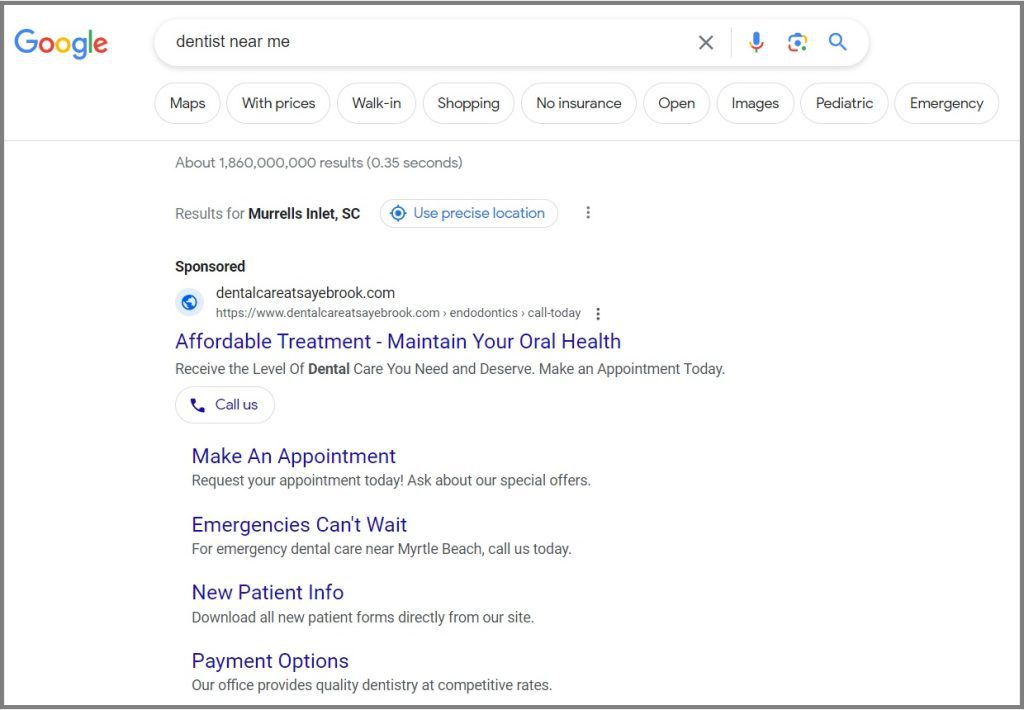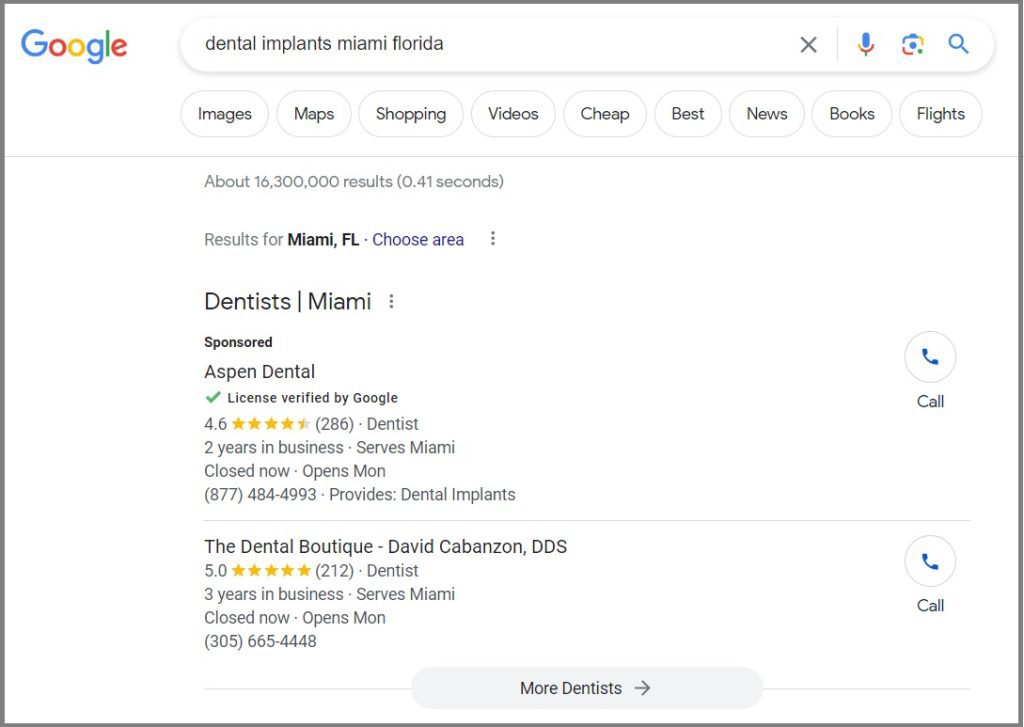The dental industry is very competitive, especially for new practices. While some dentists stay scheduled year-round with their current patients, others need more leads. That’s where Google Ads for dentists can be very effective. You can target people who are actively looking for a new Dentist.
The best part is that each patient can become a patient for life, visiting your office every six months for a cleaning and a check-up. In addition, you can target keywords for all the different services you offer, such as dental implants, teeth whitening, crowns, bridges, and even root canals.
I searched for a dentist near me, and this large ad took up the top of Google’s search engine results page. If I click on any link or call their practice, they will be charged for that individual click. This is an excellent example of a dentist’s Google Ad.

Google Ads is an example of a search ad when I look for a dentist near me.
Google Ads for Dentists: Why They Should Use It
I think Google Ads is the best online advertising platform for local businesses. While Facebook Ads and Bing Ads are great advertising channels, dental Google Ads campaigns are particularly effective because Google Ads has the most volume and ready-to-buy customers who are actively searching for something, such as a new dentist.
As a dentist, you can bid on specific keywords related to your dental practice, such as “dental implants” or “dental services,” to target potential patients actively searching for these services. With a Google Ads campaign, dentists can connect with patients looking for the specific dental treatments and procedures they offer.
Most importantly, when I searched for the best dentist around Charleston, South Carolina, you can see there are 4 advertisements at the top of the search results. It can be very competitive, and you don’t want to miss out on these searches.
Benefits of Google Ads for Dentists
Google Ads offers numerous benefits for dentists, making it an essential marketing tool for dental practices. Here are some of the key advantages of using Google Ads for dentists:
- Increased Online Visibility: Google Ads helps dentists increase their online presence, making it easier for potential patients to find them. Your dental practice can stand out in a crowded market by appearing at the top of search results.
- Targeted Advertising: With Google Ads, dentists can target specific keywords, demographics, and locations. This ensures that your ads are seen by people who are actively searching for dental services, increasing the likelihood of attracting new patients.
- Measurable Results: One of the biggest advantages of Google Ads is the ability to track and measure the performance of your ads. Detailed metrics and analytics allow you to see which ads are driving traffic and conversions, helping you make data-driven decisions.
- Flexibility and Control: Google Ads offers a range of bidding strategies and ad formats, giving dentists the flexibility to control their ad spend and tailor their campaigns to their specific needs. Whether you want to focus on clicks, impressions, or conversions, you have the tools to optimize your campaigns.
- Cost-Effective: Compared to other forms of advertising, Google Ads can be a cost-effective way to reach new patients. With a low cost-per-click (CPC), you can maximize your budget and achieve a high return on investment.
Google Local Services Ads For Dentists
Google Local Services Ads are a great way for dentists to connect with local patients through an effective ad campaign. These ads appear at the top of Google search results and feature a “License verified by Google” badge, giving potential patients peace of mind when they are choosing your practice. You can see an example of local service ads for dentists below.

By utilizing these ads, dentists can increase their visibility and attract new patients in their local area. Local Services Ads help dentists stand out and build credibility in their community. People are also more likely to contact a business that has gone through a background check by Google.
Google Ads Search Campaigns For Dentists
Running a Google Ads search ad campaign allows dentists to reach potential patients right at the moment they are actively searching for dental services. By creating compelling ad copy and linking it to a well-designed landing page, dentists can drive qualified traffic to their website and increase their chances of converting visitors into new patients. With search campaigns, dentists can capture patients’ attention when they are most ready to take action.
Creating a Google Ads Campaign
Creating a Google Ads campaign for dentists involves several crucial steps to ensure success:
- Setting Up a Google Ads Account: The first step is to create a Google Ads account. You’ll define your campaign settings during setup, including your budget, bid strategy, and ad extensions. This foundation is critical for managing your ad spend and maximizing your reach.
- Conducting Keyword Research: Effective keyword research is essential. Use tools like Google Keyword Planner to identify the most relevant and high-volume keywords for your dental practice. Focus on terms that potential patients are likely to use when searching for dental services.
- Creating Ad Groups and Ads: Organize your keywords into targeted ad groups. Each ad group should focus on a specific service, such as “dental implants” or “teeth whitening.” Craft compelling ads that include your target keywords and resonate with your audience.
- Setting Up Landing Pages: Ensure that your landing pages are relevant to your ads and provide a clear call-to-action (CTA). A well-designed landing page can significantly increase your conversion rates by guiding visitors towards booking an appointment or contacting your practice.
- Launching and Optimizing the Campaign: Once your campaign is live, continuously monitor its performance. Use the data to optimize your ads, adjust your bids, and refine your targeting. Regular optimization helps ensure that your ads are effective and driving the desired results.
Conversion Tracking For New Dental Patients
To measure the success of your Google Ads campaigns in attracting dental patients, it’s essential to set up conversion tracking. This allows you to track specific actions, such as appointment bookings or contact form submissions, and determine the return on investment (ROI) of your ad spend. By analyzing the data, you can make informed decisions and optimize your campaigns for better results. Conversion tracking provides key insights so dentists can continually refine their Google Ads approach.
Keyword Research and Planning for Google Ads
Keyword research and planning are critical components of a successful Google Ads campaign for dentists. Here are some tips for conducting keyword research and planning:
- Use the Google Keyword Planner Tool: The Google Keyword Planner tool is a free resource that helps dentists identify relevant keywords and estimate their search volume and competition. This tool is invaluable for finding high-value keywords that can drive traffic to your site.
- Identify Long-Tail Keywords: Long-tail keywords are more specific phrases that have lower search volumes but are also less competitive and more targeted to a specific audience. These keywords can help you attract highly qualified leads who are looking for specific dental services.
- Use Keyword Match Types: Keyword match types determine how closely a search query must match a keyword to trigger an ad. Dentists can use broad match, phrase match, or exact match to target their ads more precisely. Experiment with different match types to find what works best for your campaign.
- Create a Keyword Strategy: Develop a comprehensive keyword strategy that includes a list of target keywords, organized ad groups, and relevant ads. This strategy should align with your overall marketing goals and help you reach your target audience effectively.
Landing Pages for Dental Google Ads Campaigns
Landing pages are a critical component of a successful Google Ads campaign for dentists. Here are some tips for creating effective landing pages:
- Make Sure the Landing Page is Relevant to the Ad: The landing page should be directly related to the ad content and provide a clear call-to-action (CTA) for potential patients. Relevance ensures that visitors find what they are looking for and are more likely to convert.
- Use a Clear and Concise Headline: The headline should be clear and concise and include the target keyword. A strong headline grabs attention and immediately communicates the value of your dental services.
- Use a Prominent CTA: The CTA should be prominent and clear, encouraging visitors to take the next step. Include a phone number, email address, or appointment booking form to make it easy for potential patients to contact you.
- Use Trust Indicators: Trust indicators such as reviews, testimonials, and certifications can help build trust with potential patients. Displaying these elements on your landing page can reassure visitors and increase their confidence in your practice.
- Optimize for Mobile: With more people searching for dental services on their smartphones, it’s essential to optimize your landing pages for mobile devices. Ensure that your pages load quickly and are easy to navigate on smaller screens.
By following these tips, dentists can create effective landing pages that enhance their Google Ads campaigns and drive more conversions.
6 Google Ads Tips for Dentists
When running Google Ads for your dental practice, optimizing your campaigns for success is essential.
Here are some best practices to follow:
1. Start With Effective Keyword Research
Conduct thorough keyword research. Use tools like Google Keyword Planner to find high-value keywords related to your services and location. Look for keywords with search volume and low competition.
2. Use Negative Keywords
Incorporate negative keywords to prevent your ads from appearing for irrelevant search terms. For example, adding ‘free’ as a negative keyword can block searches looking for free services, saving your advertising budget by avoiding clicks from users whose intent does not align with the services offered.
3. Organized Ad Groups
Create targeted ad groups. Group keywords into ad groups around specific services, like “dental implants” or “pediatric dentistry,” for more relevant ads.
4. Write Compelling Ad Copy
Write ad headlines and descriptions that grab attention and motivate clicks and conversions from potential patients. Focus on the benefits you provide and highlight a promotion for new patients.
5. Use Optimized Landing Pages
Drive traffic to relevant landing pages that are designed to convert prospects into customers. Send visitors to tailored landing pages that match the ad content and encourage conversions.
6. Use a Smart Bidding Strategy
Use bid strategies that are focused on driving conversions like contact form fills and phone calls. You want to use a bidding strategy that will help you get the most out of your budget such as Maximize Conversions or Target CPA.
Hire Surfside PPC to Create and Manage Your Dentist Google Ads Campaigns
When it comes to paid advertising, I recommend my dentist clients use Google Ads for dental and Bing Ads (Microsoft Advertising) campaigns. That way they can reach customers who are searching Google, Google Search Partners, Bing, Yahoo, AOL, and even DuckDuckGo. Then, I work on their campaigns to drive the cost per lead as low as possible.